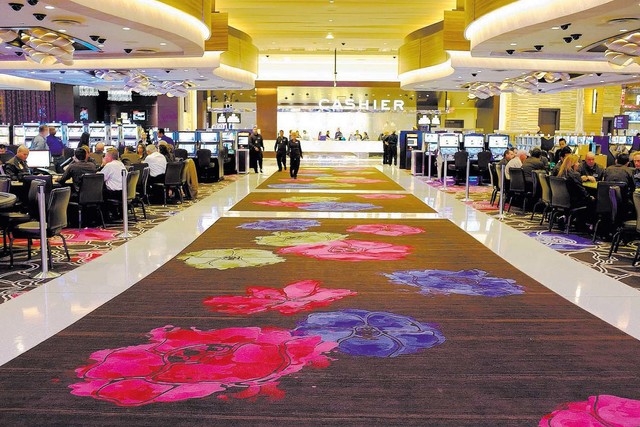Gaming revenue distinguishes commercial, Indian casinos

The lines between the commercial casino industry and Indian gaming are seemingly evaporating.
Caesars Entertainment Corp. runs Indian casinos in Phoenix, San Diego and North Carolina through its Harrah’s brand.
Station Casinos opened one of the largest California Indian casinos near Sacramento in 2003 and managed the property for seven years. The company operates an Indian casino 45 minutes north of San Francisco and an Indian casino near Grand Rapids, Mich.
If California voters sign off on a ballot referendum next month, Station Casinos will open an Indian casino near Fresno.
Meanwhile, Penn National Gaming is building a $350 million Indian casino east of San Diego.
But in most ways, the lines of division are pretty solid.
Take gaming revenue.
State casino regulators in commercial markets release monthly and annual gaming revenue reports. In many states — including New Jersey, Pennsylvania, and Louisiana — the figures are broken down by individual casinos.
Indian gaming numbers are a tightly held commodity.
California economist Alan Meister produces Casino City’s annual Indian Gaming Industry Report, a comprehensive state-by-state roundup of Indian gaming revenue. But the figures are always a year behind because it takes Meister 12 months to compile the numbers from each state. The 2014 report covered 2012.
Meanwhile, the Washington, D.C.-based National Indian Gaming Commission releases an annual gaming revenue report for the previous calendar year. But numbers are broken down by seven geographic regions.
Analysts said it’s hard to compare the commercial casino industry — defined as Las Vegas-style resorts, racetrack facilities and riverboats — with their tribal gaming counterparts because the numbers are not transparent.
“The Indian casino industry has to be willing to share data,” one gaming insider said.
The Casino City report doesn’t break down individual casino results. The Indian Gaming Commission hides markets.
In July, the commission said its Sacramento region had revenue of $7 billion in 2013, the highest in the nation. The region includes California and a portion of Northern Nevada.
Northern Nevada has one property considered an Indian casino — the Crosby Lodge at Pyramid Lake in northwestern Nevada, about 40 miles from Reno. According the Nevada Gaming Control Board, the restricted location has 15 slot machines, not much to move the needle.
The current investments by publicly held gaming companies into Indian casinos don’t offer much information. Operators are often paid a flat fee and a percentage of revenue or cash flow.
“Sometimes, a little light might be shed, but it’s not very clear,” Union Gaming Group analyst Robert Shore said.
But Station Casinos revealed results from the Graton Resort near Santa Rosa, Calif. The company manages the casino for the Federated Indians of Graton Rancheria.
In the quarter ended March 31, Station Casinos said Graton generated $101 million in revenue and $57 million in cash flow. The company earned $7.4 million in management fees.
Credit Suisse gaming analyst Joel Simkins told investors the Graton numbers make the resort one of the most profitable and highest margin regional casinos around.
Jana McKeag, president of Lowry Strategies, an Alexandria, Va.-based public affairs agency, said the tribal casinos have different financing issues and varying government compacts.
McKeag, a member of the Cherokee Nation of Oklahoma who helped form the Indian Gaming Commission in 1991, said comparing commercial casinos and tribal gaming is unfair.
“It’s like comparing the American Red Cross with Shell Oil,” she said. “Tribal casinos are government operations and the proceeds go to members. Commercial gaming has stockholders or they are private companies.”
No one argues that Indian Gaming hasn’t become lucrative.
The Strip — long considered the nation’s No. 1 gaming revenue producing destination — may not be atop the pack if California is included.
The Casino City report said California’s 68 Indian casinos produced $6.96 billion in gaming revenue in 2012. The Strip’s 42 casinos had gaming revenue of $6.2 billion that same year, according to the Gaming Control Board.
The Sacramento region’s $7 billion in revenue, according the Indian Gaming Commission, easily topped the $6.5 billion produced by the Strip resorts in 2013.
The American Gaming Association believes casino customers don’t distinguish between one casino type or another.
At the Global Gaming Expo last week, the Washington-based trade association released an economic impact study that looked at both commercial and tribal gaming and the bearing the businesses have on local communities.
The study, conducted by the Oxford Economics, found the two industries and gaming manufacturers produced total revenue — gaming and nongaming — of more than $87 billion in 2013. The total economic impact was nearly $240 billion.
“The way the gaming consumer looks at it, it’s all gaming,” association President Geoff Freeman said.
Early Indian casinos were often considered second-rate to commercial properties. But not anymore.
In Florida, the Seminole Indian Tribe operates seven casinos, including the Hard Rock resorts in Tampa and near Fort Lauderdale. Racetrack casinos competing with the Seminoles for customers are viewed differently.
Shore said the Seminoles recently offered a promotion at the Hard Rock that gave away a Mercedes-Benz as a car-a-day prize.
“The racinos were giving away free vacuums,” Shore said. “There is a difference.”
The Seminoles have a compact that the tribe pays Florida at least $234 million a year for forms of gaming exclusivity. The figure is expected increase when the compact is renegotiated before it expires in July.
Florida’s racetrack casinos pay a 35 percent tax on gaming revenue.
The bottom line is, the lines of division are still pretty solid.
Howard Stutz’s Inside Gaming column appears Wednesdays and Sundays. He can be reached at hstutz@reviewjournal.com or 702-477-3871. Follow on Twitter: @howardstutz.